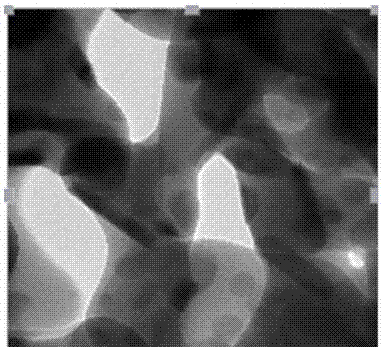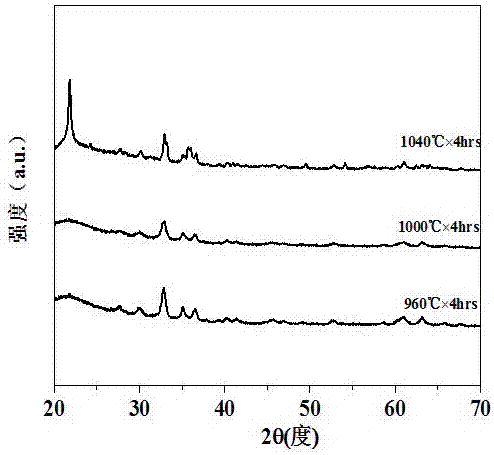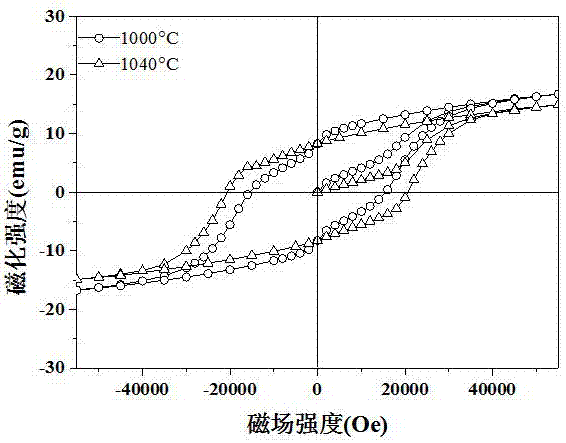Method for induced-growing Epsilon-ferric oxide nano-rod by lead ions
An iron oxide nano and lead ion technology, applied in iron oxide, iron oxide/iron hydroxide, nanotechnology, etc., can solve the problems of fluctuation of synthesis process stability, weakening of induced growth effect, narrow synthesis temperature range, etc. The effects of practicability and application value, strong synthesis stability, and convenient operation
- Summary
- Abstract
- Description
- Claims
- Application Information
AI Technical Summary
Problems solved by technology
Method used
Image
Examples
example 1
[0028] 1. Preparation of precursor powder by inverse microemulsion-gel method:
[0029] Prepare water phase I: use lead nitrate and ferric nitrate nonahydrate as raw materials to prepare a mixed metal solution with a mole of water of 1.5 mol, that is, water phase I. The concentration of iron ions is 0.05 mol / L, and the molar ratio of lead ions to iron ions is 1:9.
[0030] Preparation of water phase II: Mix concentrated ammonia water and deionized water to prepare an ammonia solution with 1.5 mol of water, that is, water phase II. The concentration of ammonia water is 1 mol / L.
[0031] Prepare two suspensions: each consisting of a mixture of 50 mL of n-octane, 0.4 mol of n-butanol, and 0.05 mol of cetyltrimethylammonium bromide (CTAB).
[0032] Preparation of microemulsion system I: Mix the above part of the suspension with water phase I to obtain microemulsion system I.
[0033] Preparation of microemulsion system II: Mix another part of the above suspension with water pha...
example 2
[0040] 1. Preparation of precursor powder by inverse microemulsion-gel method:
[0041]Prepare water phase I: mix lead nitrate, ferric nitrate nonahydrate and water to prepare a mixed metal solution with 1.5 mol of water, that is, water phase I. The concentration of iron ions is 0.05 mol / L, and the molar ratio of lead ions to iron ions is 1:10.
[0042] Preparation of water phase II: Mix concentrated ammonia water and deionized water to prepare an ammonia solution with 1.5 mol of water, that is, water phase II. The concentration of ammonia water is 1 mol / L.
[0043] Prepare two suspensions: each consisting of a mixture of 50 mL of n-octane, 0.4 mol of n-butanol, and 0.05 mol of cetyltrimethylammonium bromide (CTAB).
[0044] Preparation of microemulsion system I: Mix the above part of the suspension with water phase I to obtain microemulsion system I.
[0045] Preparation of microemulsion system II: Mix another part of the above suspension with water phase II to obtain micr...
example 3
[0053] 1. Preparation of precursor powder by inverse microemulsion-gel method:
[0054] Prepare water phase I: mix lead nitrate, ferric nitrate nonahydrate and water to prepare a mixed metal solution with 1.5 mol of water, that is, water phase I. The concentration of iron ions is 0.05 mol / L, and the molar ratio of lead ions to iron ions is 1:12.
[0055] Preparation of water phase II: Mix concentrated ammonia water and deionized water to prepare an ammonia solution with 1.5 mol of water, that is, water phase II. The concentration of ammonia water is 1 mol / L.
[0056] Prepare two suspensions: each consisting of a mixture of 50 mL of n-octane, 0.4 mol of n-butanol, and 0.05 mol of cetyltrimethylammonium bromide (CTAB).
[0057] Preparation of microemulsion system I: Mix the above part of the suspension with water phase I to obtain microemulsion system I.
[0058] Preparation of microemulsion system II: Mix another part of the above suspension with water phase II to obtain mic...
PUM
| Property | Measurement | Unit |
|---|---|---|
| diameter | aaaaa | aaaaa |
| diameter | aaaaa | aaaaa |
Abstract
Description
Claims
Application Information
 Login to View More
Login to View More - R&D
- Intellectual Property
- Life Sciences
- Materials
- Tech Scout
- Unparalleled Data Quality
- Higher Quality Content
- 60% Fewer Hallucinations
Browse by: Latest US Patents, China's latest patents, Technical Efficacy Thesaurus, Application Domain, Technology Topic, Popular Technical Reports.
© 2025 PatSnap. All rights reserved.Legal|Privacy policy|Modern Slavery Act Transparency Statement|Sitemap|About US| Contact US: help@patsnap.com



